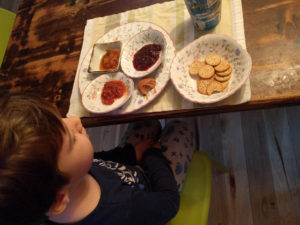Develop Healthy Eating Habits by Changing your Kitchen Defaults – Part 1
Our little guys tried more varieties of food before they turned five than Karen and I have before turning twenty-five. One reason is availability. Specialty foods have gone mainstream so a Slim Jim has to cozy up to sheep jerky and pomegranate is about as exotic as Peanut M&Ms. Taking advantage of variety has really aided in developing our boys’ robust palate.
We’ve been asked how we go about designing our meals as well as what we buy at stores. This is a two-parter since Karen has a professional background in picky eating and I’m just a reformed picky eater who tries to keep it healthy.
Here are some default settings I generally follow. The first thing to make your unhealthy foods yourself. If I crave a muffin or brownies we try to make it from scratch. So we can appreciate the work that it takes to make it and what ingredients it takes. We have cookies in the house but they’ve not made by Nabisco. Cooking your own food, even if not totally healthy, will give you knowledge that translates to healthy cooking.
Another default is planning your meal around the veggie. We always have proteins in our meals, but ensuring the vegetable is cooked in an appealing way ensures the kids get the nutritional benefit. This could mean leaving some foods raw, like snap peas or bell peppers or steaming broccoli or boiling peas. I also invited other veggies in every recipe. We add cooked sweet potato to pizza crusts or adding green vegetables to store-bought mac n cheese. Sneaking veggies into foods is all the rage and half the pasta aisle seems to be made up of noodles from everything from spinach to seaweed.
Tips & Tricks
Here are a few other tips/tricks and defaults we turn to make cooking and planning with kids.
- A treat at the supermarket is letting the kids pick their own fruit. They’ve had fun picking out dragon fruit, jicama, and other strange-looking fruit that just wasn’t available twenty years ago.
- If kids pick it, pack it, stir it, chop it and add it, chances are they’ll eat it.
- Never toss out bananas. The darker they get, the sweeter they’ll taste in a smoothie. Freeze them. The kids love designing their smoothies. They’ve used just about everything in the fridge and spice rack.
- Never tell them it won’t taste good, even if it’s a cumin, basil, banana, and watermelon smoothie.
- Pack your pancakes with fruit and greek yogurt. I don’t like greek yogurt but find it pretty good if it’s been hidden in something baked.
- Add frozen berries to cooked oatmeal to cool them down faster.
- Not just pancakes use greek yogurt in everything. It’s super versatile and adds a bit of tanginess to Italian dishes. It’s also a great way to stave off your appetite at night.
- Only use half the Mac n’ Cheese additives in boxed mac and cheese. Use the extra additives in your burger mix for a little extra cheesiness.
- It’s okay to toss unhealthy foods. If you wouldn’t feed it to your dog, it’s better off in the bin.
- Use a calorie counter. It’s a good practice to check the cumulation of the foods you’re taking in as a baseline — no need to do this every day. Many apps can handle this, and you don’t need to be obsessive about making it happen. It’s a good idea to check on occasion what nutrients you may need help with or if you’re taking in more sugar than you realize.
- Our favorite snacks – unsweetened applesauce, carrots, greek yogurt, snap peas, pb&j, naked popcorn, bell pepper slices, string cheese, as well as every type of nuts we can find.
The thing is, keeping it healthy has gotten harder. Our rules haven’t changed much since they were two, but they are much more independent at five. Now they don’t always think rules apply, and that’s perfectly fine. They will still go to the fridge and pull out snap peas or finish off a pint of strawberries at a sitting because that’s what they like and it makes them feel good
We’ll be back soon with Part 2 – Grade School Snaking




 My boys actually had tantrums when the other drank the “broccoli juice” from the bottom of the broccoli bowl at dinner. They read my version of that book since they were 6 months old. They are listening and learning very early on and developing their relationship with food in many different mediums of learning. They include language (both written and verbal), observation (watching family & peers), environmental (opportunities for mass exposure to a variety of foods) and most importantly, experience (being active participants in selection, manipulation/play and tasting); notice I did not mention eating. Eating is at the very top of all the layers of foundation a child has to experience before getting to the last step of eating.
My boys actually had tantrums when the other drank the “broccoli juice” from the bottom of the broccoli bowl at dinner. They read my version of that book since they were 6 months old. They are listening and learning very early on and developing their relationship with food in many different mediums of learning. They include language (both written and verbal), observation (watching family & peers), environmental (opportunities for mass exposure to a variety of foods) and most importantly, experience (being active participants in selection, manipulation/play and tasting); notice I did not mention eating. Eating is at the very top of all the layers of foundation a child has to experience before getting to the last step of eating.

